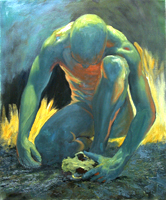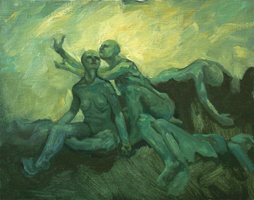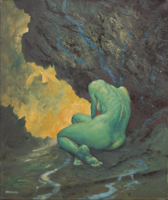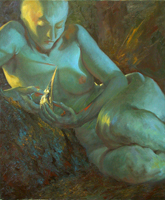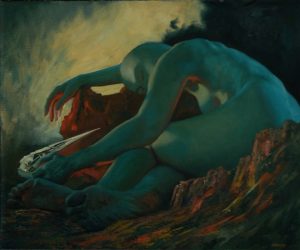Article by John Mendelson
We are in a blasted landscape of craggy outcroppings and leafless trees, lit by a ochre sky edging toward night. In this God-forsaken setting, a lone figure reclines on the dark, oily earth. Naked, with green-blue skin, and illuminated by an eerie light, this strange soul holds what appears to be a fragment of an animal’s skeleton.
This is the dramatic scene that Peter Granucci has conjured forth in Mourning the Loss, his recent series of paintings. The series is comprised of five groups which explore loss and grief, with an immediacy that is vivid and visceral. We are confronted by images that speak to us directly of suffering, contemplation, and the slender hope of redemption. The artists peaks eloquently in the language of the body: the torso that twists, the arms that embrace the self, the back bent low in surrender. Hands clasp in aguish, gesticulate against the sky, or tenderly cradle a poor creature’s remains.
It is left to the viewer to enter Granucci’s apocalyptic world and come to terms with the same tragic mystery with which the figures struggle. A key lies in the figures themselves. Solitary, naked, without hair, and strangely tinted, they have morphed into embodiments of loss. They are earless, seemingly in response to a world where nature has become silent. These mostly female figures, holding reminders of life extinguished, are archetypal in their monumental mourning. It is as if nature has fallen victim to a massive ecological catastrophe, that has rendered it toxic and withered, its species succumbing to extinction. The figures, simultaneously abject and nurturing, through their bodies give voice to nature’s cry.
Granucci has taken to heart the environmental warnings that threaten to become a global emergency and has rendered them in almost shockingly human terms. The painting Intimate Loss #6 shows a figure with its head hidden in its arms, sitting in the sharp ruins of a great tree that looms before a cloud-filled sky. In one hand the figure holds a heron’s skull. The image is both painful and somehow exalting. The human presence seems to imply an ongoing witness to the world. For all its fantastic grotesquery, the scene bespeaks an urgent moral consciousness.
Granucci’s paintings mourn not just endangered nature, but the human condition itself. Vulnerable and yet persisting, humanity is honored even in its darkest hour.
John Mendelson
Essay by Jonathan Goodman
Peter Granucci is a figurative painter based in New Hampshire who paints powerful allegories of the human condition. His art courageously takes on the problem of existential meaning at a time when such exploration is often neglected, or even dismissed, by much of the contemporary art community; however, Granucci persists in his mission to describe people and nature at their most basic or primal. He sees our situation as metaphysically troubled–the implications of much of his art are pessimistic in that they offer few alternatives to the troubled, casually ravaged world in which we live. Yet, at the same time, there is a deep-seated commitment toward hope in the sense that Granucci paints feelings in their most elemental state–in an artist’s statement, the artist comments, “I hope to express deep raw emotions (passion, loss, struggle, despair, hope) that are from my (our) core being. I hope to show our universal common self, that part of us that we all share, so perhaps, we can experience more compassion for each other.” Granucci’s comment sheds light on his personal motivation, namely, to render the universalization of feeling within a figurative format, but it can also be said that the artist addresses the natural world–many of his figures hold small animal skeletons–and its tragic devastation in the contemporary era.
The titles of Granucci’s series–“Contemplation,” “All That Remains,” “Railing Against Our Nature,” and “Alone in the Grief”–give a sense of the artist’s seriousness of purpose and eloquent choice to portray tragic elements in our nature. In one work from “All That Remains,” a naked man crouches before us, with one knee up. His hairless head is bent down, and he holds a small animal skull; while his body is surrounded by light, the foreground and background elsewhere is a dark bluish green. It is a grim rendering of human life at its elemental, yet the painting contains hope as well; a warm red light glows in his torso, where his heart is found. In another image, from the series “Alone in the Grief,” we are given the back view of a naked woman crouching in what seems to be a blasted field; the way she is posed, we cannot see her head, only the strong curves of her body. In conversation, the artist has acknowledged our current ecological situation as “terribly sad,” and there is in this painting, and throughout the body of Granucci’s work, the suggestion of natural tragedy. A large part of the power in his art derives from his willingness to confront the immensity of natural destruction within an intimate format; the paintings speak allegorically to our condition, commenting on our troubles by representing them symbolically.
But, again, there is often, if not always, a promise of hope in Granucci’s paintings. The contemplative element in his art is by itself a positive activity, one from which action may be taken. Granucci doesn’t offer an answer to our strange, philosophically senseless destruction of nature; instead, he presents us with tableaus of meaning, in which the essential seriousness of the best of our selves is implicitly praised. In one painting, from the “Railing Against Our Nature” series, which is unusual because it is a portrait of a group, the artist enigmatically places four people, all of them nude and hairless, in a rocky domain. Two of the figures abjectly recline on the right of the painting, while in the center two (a man and a woman) sit, the man extending his arms into the darkly yellow-green background. His activity serves as an act seemingly negating the despair around him; despite the deeply pessimistic implications of the color and poses, someone is extending what might literally be called “a helping hand.” Granucci’s art is filled with a high moral purpose that helps him save his paintings against his own reading of our fate; he sees our common earth as nearly scorched yet finds meaning in the representation of figures that suggest possibility and even hope. In this sense, he is a visionary realist, not only in his style but also in his thinking.
Jonathan Goodman
Article by Annika Kristiansen
Some of the most curious queries of human existence evolve out of man’s precarious
connection to the natural world. The human condition: birth, growth, emotionality, aspiration,
conflict, and mortality are most intimately interwoven with the first chartreuse-hued buds that
appear in spring after a dark winter, the overpowering gush of mighty rivers that carve their own
paths on the seemingly impenetrable face of our earth, the wise, weathered trees and delicate
young saplings that are life-giving and watchful, and the other sentient beasts; handsome, witty
creatures that share all of these things with us.
Religion, philosophy, literature, anthropology and biology each offer a lens from which we
ponder and make sense of the unknown. What does it mean to be human in the vast nexus of
life that seems to know no bounds except for the ones which we impose? How far does our
power extend and what boundaries should be placed on our own selves as we interact with the
natural world? What can emerge from the murky margins between this innate visceral and
mysterious animal intuition and the human intellect?
In the thickly-wooded, New England town of Gilsum, NH, figurative painter, Peter Granucci,
chooses art as his genre of investigation as he delves into the dark and gritty facets of
humanity. “I try to get at that sense of the enormity of our personal, emotional, and, for lack of a
better word, spiritual, connection to life and the world.” Peter is speaking to me as we perch on
worn mismatched chairs in his barn-studio. The sturdy walls of the long-standing barn are
draped in beautiful fabrics which, high up, give way to strong, hand-hewn, wooden beams. The
space is other-worldly; the artist’s secret world— the birthplace of angels, half-human creatures,
and wise-eyed animals which stare back from oil and charcoal-marked canvas. I feel entrusted
with a kingdom of contemplation, deliberation, and musing.
Granucci is profoundly troubled by the human condition—a situation of metaphysical
disturbance. An estrangement from the objects and the rich processes of labor from one
another and from nature have resulted in an alienation from the self. Memorial to Lost Species,
a series that directly addresses the harm that has arrived with the age of humans, is one of
Granucci’s greatest works. In the age of the Anthropocene, the artist’s portrayal of dark-hued,
aggrieved, human forms grasping the tiny animal skeletons of lost species, is in direct address
of the harmful hand of humans.
“I totally believe in profound experiences of oneness with the universe,” he tells me, peering
over a well-loved cup of now-cold coffee, “because I’ve experienced them, really deeply, really
powerfully, and not just once.” Granucci tells me about a memory from high school when he
attended a National Outdoor Leadership School in Wyoming, and spent the whole summer
hiking through the Wind River Mountain Range, rock climbing. Later he tells me, he would go
winter camping, digging snow caves in 20-something-below temperatures to spend a night, and
skiing to the next location by day. “I was totally separate from the ‘real world’ nowhere near any
roads. You’d see a jet go by overhead every couple of weeks or something, that’s all. It was
experiences like these for the young artist that would prove to be some of the greatest
influencers of his life and artistic expression in later years. Perhaps it was isolation in nature that
allowed him to reflect on what it meant to be human, separate from the human-world. Perhaps it
was the rare whir of jet-engines overhead that reminded him of the far-reaching impact and
power of humanity. Today, the artist continues to value isolation. “I really like to be alone,” he
tells me, slightly embarrassed, “house at the end of the dirt road, and the barn with the studio in
the way back. There are many layers of protection here.” Then more confidently, “It’s the perfect
place for an introvert, and that’s what I am, an introvert. I can’t deny it.”
Granucci’s childhood love of dinosaurs and mythical creatures transformed into a love of
animals as he grew older. For him, the creatures living on his farm are miraculous beings that
have a wealth of information to share, “I’ve got maybe a hundred animals here on the farm and
they act just like people,” he says with a flourish of his coffee cup, “If there’s food they go to it,
when they get too crowded they beat each other up. I don’t see any difference. Sure, we have
certain cognitive abilities, and verbal skills so we can put words to things. But I think, I can see
in the sheep’s eyes what people would feel in the same situation.” For Granucci, the animals are
also a daily reminder of his responsibility as their caretaker. He refers to the buying of his farm
as a life-changing event, a moment when he came to life. His charge, an obligation to the lives
that rely on him on this farm, he considers passionately in his Memorial to Lost Species. His
considerations for the series, he tells me, began with frogs. The permeable skin on the typically
biphasic-lived amphibians along with their crucial positioning in the food-web makes frogs some
of the best biological indicators of the wider health of ecosystems. These critters, which have
lived for more than 300-million years on earth have lost about 200 species to extinction thus far,
and hundreds more are predicted to be lost in the next decade. “Just realizing so many
incredible creatures—so bizarre and freaky, and amazing—are going extinct, was beyond what I
could handle.” So, he tells me, “I had to paint for two years to process that idea.” The grim
reality that Granucci grapples with, however, is much vaster than the frogs. When one part of
the immense, interconnected, and inter-reliant web of life is taken away, the whole system
changes. If the frogs are dying, who else is suffering? What is the much deeper loss
experienced by humans when the world hurts in this way, and when it is hurting in this way
because we have not done right by it?
Granucci is influenced by names like Harvey Dinnerstein, Silverman, and Moses Sawyer, whose
work he sees as explorations into the human experience. “Their works are gritty. They dealt with
not just the pretty side of life; they dealt with the harder side of life. They weren’t ugly paintings
by any stretch, but they were honest portrayals of the human condition.” Granucci sees hope in
mankind’s ability to tap into a “universal common self.” Imaginably, the root of this phenomenon
harkens back to animal instinct and a certain sixth sense that allows us to understand more than
the apparent. Yet, there is a very-human aspect to this capacity for compassion, empathy, and
beyond-superficial consideration. Granucci shares some of his most private longings as he
speaks to the expressions of deep, raw emotions—passion, loss, internal struggle, despair and
hope—that he has poured into his Memorial to Lost Species series. He refers to these emotions
as sourced directly out of his/our core being, implying that they are primal and experienced by
that part of us that we all share as humans.
On to our second cup of coffee, the wool-vest-clad, gray-haired artist stands up to stoke the
wood stove that heats his studio. I suggest a break in our conversation but it moves him to
speak on another topic: balance. Granucci finds that balance in life is the key ingredient in
making meaningful art. Spending time with his wife and his friends provides mind-space from his
work and influential fodder in the form of ideas. His animals, too, he tells me, offer valuable
insights and are a reason to take time away from his work. “The nice thing about animals is that
they’re alive, and you can’t ignore them. So, you have to devote time to them, and I want to, I’m
not doing it resentfully. I love doing it.” Granucci’s chicken coops are strategically positioned far
away from the front door along with the woodshed so he is reminded to go outside. “Making the
effort to spend time outside, to do things, to care for the living beings, to chop wood, helps me
balance my life in a really wonderful way.” The artist uses his hands to build, to chainsaw, and
also, to write poetry if the urge surfaces. He reads me one; a haiku. It is wonderfully simple and
provides a description of the turkeys around his home as they take flight over a “hot wire fence.”
When inspiration strikes, however, the axe can be mid-chop when the artist scurries back to his
haven in the barn. “When I have an idea, I tend to get locked on to a path and just skid into it,
skid into the corner and go down the road for a ways,” he says. “That’s kind of what I meant
before when I said I don’t really have a method. Some of my things, they just evolved out of one
choice at a time.”
Taking this balance into the studio means many things for Granucci, he tells me of his
experience working on the memorial series. “I’ve kind of split myself into several people. So
when I do my memorial series, I can really live into the darker side. On the one hand, these
works are dark and they’re brooding, but at the same time there’s beauty and balance and little
shimmers of light.” This bit of light is significant in his pieces, they offer a glow around the
human form, the hint of some warmth—a fire perhaps. Clay and crimson splashes suggest life,
and hope as they intimately accentuate the dark rocky crags and the hands of anguished and
despairing figures.
At this point in our conversation, I take a long glance at the masterpieces which line the soaring
walls, lean up against chair legs and old easels, and even one another. “So why do we need
art? Why do we need artists?” I ask. I know it’s a trivial inquiry, but his answer is spot on, and
well thought out. This artist, I realize, sees his work as a responsibility to the world; to society.
This is what he tells me,
“Artists reveal the ubiquitous nature of humanity. They aren’t special what they are is in
the midst of the core of how people feel and respond to life. Artists merely expose
ourselves to ourselves. To be special means you’re different, above, and without
responsibility, artists are not special, but they do have important work to be done. Some
religions make their people special. We don’t need to look hard to see what that can do.
Some politicians think they are special, above the law and everyday honesty, we also
don’t need to look hard to see what that can do.”
And, this is the moment that I gain another depth of understanding into Granucci’s Memorial to
Lost Species. Humans inherently think hierarchically and this is our most dangerous attribute.
When there is hierarchy there is the idea of “special.” Our actions and inactions on this earth are
without thought given to the ramifications which result. In our striving to become “more human”
and more advanced we have evolved into brutes who speak for nature rather than hearing what
she has already said and only mourn our losses when they have immediate consequences.
Granucci’s work carries the pain of the present and of the future. There is much mourning to be
done now over the current detached human condition, and there is much mourning to come as,
when as a result of this detachment, we have destroyed everything that we love, everything that
sustains us, and everything that makes us who we are.

